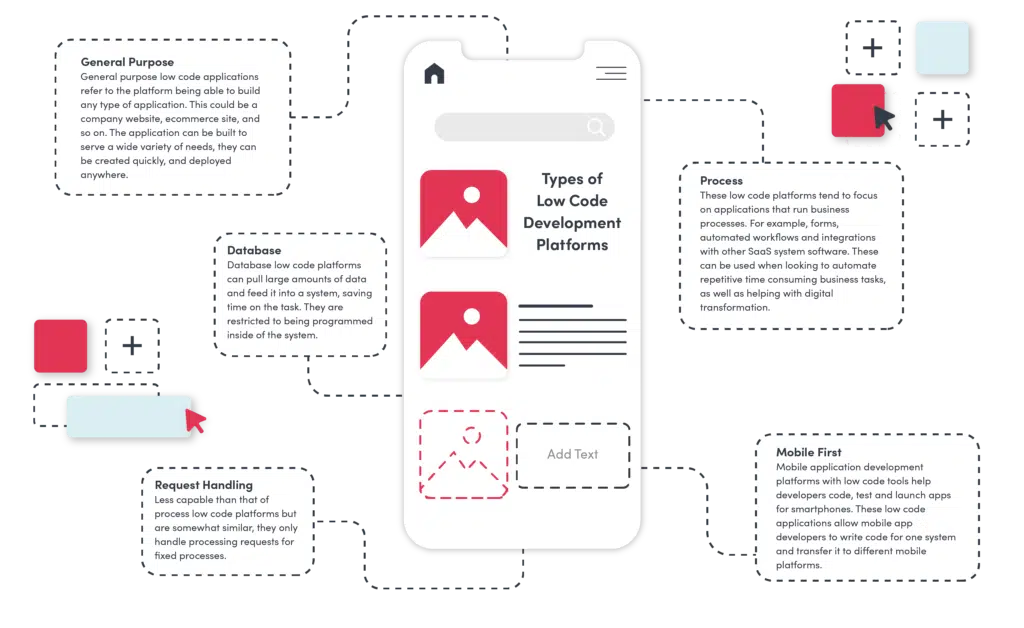Good Tips On Picking Low-Code Platform Recommendations
Good Tips On Picking Low-Code Platform Recommendations
Blog Article
The Benefits Of Low-Code Development For Speed
Visual Development Environment (VDE):
Drag-and-Drop Interfaces: Low-code platforms provide visual tools for designing applications. Drag-and-drop elements let developers quickly create applications without the need to write extensive code.
Many low-code platform come with already-built templates and parts. This allows developers to quickly prototype or build applications without starting with a blank slate.
Reducing Coding requirements
Automated Code Generation: The low-code platform automatically generates code beneath based on the visual models created by developers. This means that there is less manual code coding.
Reusable Components: Developers are able to use reusable components across different projects, thus reducing the time they spend writing and testing code.
Collaboration Streamlined:
Low-code platform tools usually contain versions control, testing, or deployment. This allows for seamless collaboration between teams.
Citizen Development: People who are not developers and business users can use intuitive interfaces to contribute to the development of applications, which helps reduce bottlenecks triggered due to a shortage of professional developers.
Rapid prototyping, rapid iteration and rapid prototyping
Fast prototyping: Developers can create quickly prototypes in order to gather feedback and confirm ideas, which results in quicker iterations.
Easy Modifications. The visual nature of low-code development allows users to modify and update their apps.
Pre-built Integrations:
API Integrations: Low-code platforms are often pre-built with connectors to popular services and APIs. This can reduce the time required to connect external systems.
Data Integration: Built-in tools for data-integration simplify the connection to databases and other data sources. This speeds up development.
Deployment and Scaling:
One-Click Installation: Many low-code platforms have an installation with a single click that reduces the amount of effort and time required to set up applications.
Cloud-Based Platforms: Cloud-based platforms that have low-code capabilities can manage the infrastructure and scale, which means developers can concentrate on the the logic and performance of their applications rather than the logistics of deployment.
The most significant benefit of low code application development with regard to speed, is its capacity to automatize and simplify many aspects of the process. This allows for quicker delivery of applications and more rapid adaptation to changing needs. Check out the recommended the full details for more examples including cross platform mobile development, azure sql, cross platform app dev, cloud software applications, mobile development platforms, developing mobile apps, no code platforms, ms azure sql, cross platform mobile dev, push alerts and more.
Low-Code Application Development Offers Numerous Advantages In Terms Of Cost-Effectiveness
Low-code application creation offers many advantages in terms of cost-effectiveness. Companies looking to optimize budgets can benefit from this method while still delivering high-quality applications. These are the main benefits:
Fewer Coding Requirements: Low codes platforms remove the need for lengthy hand-coded, custom-built applications. Developers can spend less time and effort building apps. The result is lower labour costs.
We need fewer developers: Development that is low-code requires less time and is simpler. This means fewer developers are required. This can drastically reduce costs of staffing and hiring.
Faster Time to Market:
Accelerated cycle of development Visual tools for development as well as pre-built components offered by platforms that use low-code allow rapid design of applications, which allows firms to bring their products to market more quickly. This will result in faster revenue generation and improved standing in the market.
Rapid Prototyping: Businesses are able to quickly create prototypes and then test them, thus reducing the time spent in the development phase and allowing faster iterations based on user feedback.
Lower Maintenance Costs:
Because of their modular design and standardised components, low-code platforms generally make it easier to maintain applications. The ongoing maintenance and support costs are reduced.
Automated Patches and Updates: Low-code platforms can manage updating and patching applications automatically. This means that the application is protected and always up-to-date without extensive manual intervention.
Efficient Resource Utilization:
Contributions from non-developers: Low code platforms enable non-developers for example, business users to participate in the development process. This democratization enables companies to benefit from the expertise of a broad spectrum of employees.
Optimized use of IT resources IT departments get the chance to concentrate on more strategic projects instead of getting bogged down with mundane development tasks. Overall efficiency and productivity are increased.
Price models that can be scaled:
Subscription Pricing: Many platforms that use low-code provide flexible pricing models based on subscriptions that are scaled in accordance with usage. This allows businesses the ability to adjust their spending in line with their growth and needs, without having to pay large upfront costs.
Pay-as-you-go: Certain platforms provide pay-as-you-go options. This lets businesses only pay for the resources they actually use. This is especially useful for startups and small-sized businesses with a limited budget.
Reduce the costs of third-party software
Built-in Functionalities : A low-code platform often comes with built-in functionality and integrations which reduces the requirement for third-party software, tools, and licenses.
Pre-Built integrations: These pre-built systems and services can be integrated with popular services, which eliminates the need for custom-built software, and can save time and cost.
Improved ROI
Faster ROI: Businesses can gain a greater return on investment from their apps by combining speedy development, lower costs and speedier time to market.
Increased agility: Businesses are able to adjust quickly to changes in the market or customer demands, which allows them to remain relevant and make the most of new opportunities.
Costs of training are lower:
User-Friendly Interfaces: The intuitive interfaces and user-friendly features of low-code platforms help to reduce the learning curve thus eliminating the need for lengthy training.
Accessible Resources. A lot of low-code platforms offer complete training materials including tutorials, training, and community support. They make it less necessary for formal education, which can be expensive.
Streamlined Collaboration:
Collaboration Tools: These tools enhance communication and coordination between teams, resulting in improved process for development and reduced overhead.
Unified Development Environment. A single integrated software development environment can streamline processes and cut down on the cost and complexity of managing multiple software and platforms.
The efficiency of low-code application development is due to its ability to reduce development and maintainance expenses, speed up the time to market, improve resources, and offer flexible pricing models. These factors deliver significant financial advantages to companies and make low-code a compelling option for organizations who want to make the most of their budgets and create quality, robust, and scalable apps. Read the most popular Enterprise application development with Low-code Platform for site tips including develop web app, application development platforms, azure sql server, azure sql, application modernisation, app dev platform, azure sql, build with docker, ms azure sql, low code platforms and more.
Benefits Of Low-Code App Development In Terms Limitations And Customization
Low-code application development is a well-balanced solution that offers significant benefits in addressing limitations while providing the ability to customize. These are the advantages:
: .
Simplified Development: Low-code platform simplifies development by supplying templates and components that are pre-built. This allows for faster creation and deployment.
Numerous platforms offer wizards and guided workflows to help developers navigate complicated procedures. These tools minimize the chance of making mistakes, and ensure uniformity.
Solutions for scaling:
Scalability is a part of the Low-code platforms typically include features that allow for the development of scalable architecture. Applications are able to handle higher workloads with minimal changes.
Performance Monitoring: The tools which monitor and optimize performance can help ensure that applications are efficient even as they expand.
Security and Compliance
Integrated Security Features : Low code platforms are equipped with security features that are built in including encryption and role-based access controls. They also perform automated checks for compliance to deal with security concerns.
Regular Updates: Platforms frequently update their security protocol and compliance policies. This helps ensure that applications are secure from new threats.
Customization:
Extensibility:
Custom Code Integration : A low-code platforms typically allow for the integration of custom code (e.g. JavaScript, Python), which allows developers to enhance the capabilities beyond what is available in the standard features.
Developers can create custom plugins and modules which add features that are tailored to specific business requirements.
APIs and integration:
API Support: Full API support permits seamless integration of services and systems from outside. This facilitates the ability to customize and connect.
Third-Party Services : Low-code platform typically provides pre-built connections to popular services from third parties, making integration and customization easier.
Flexible UI/UX Designs:
Customizable User Interfaces: Developers can modify and design user interfaces that meet specific specifications for branding and usability and provide a customized user experience.
Responsive design: The ability to customize applications for different screen sizes and devices is built-in.
Business Logic Customization
Visual Workflow Builders - Visual tools that allow you to design and customize workflows, business logic and processes allow developers to develop complicated and customized processes without the need for programming.
Conditional Logic and scripting: Platforms can support conditional logic as well as custom scripting to deal with specific business rules.
Data Management
Custom Data Models Developers have the ability to create customized data models specifically for particular applications, tailoring data handling to specific business requirements.
Advanced Data Processing : Integration with the latest tools and capabilities for data processing allow customization in how the data is processed, analyzed and utilized within your application.
Balancing limitations with customisation:
Frameworks and Standards
Best Practices: Low-code platform encourages adherence to standards and industry best practices. This helps in maintaining high quality, scalable and secured applications.
Governance Frameworks: Built-in governance frameworks ensure that the customizations don't compromise the integrity, security, or compliance of the application.
Iterative Development:
Rapid prototyping: By being capable of rapidly prototyping and test customizations, developers are able to refine their designs based on the feedback of users to enhance the app.
Continuous Improvement: Low-code systems permit continuous improvement, allowing for continuous customization and improvement when business requirements change.
User Empowerment
Enabling Citizen Developers to Develop: By enabling non-developers to customize their applications using easy interfaces, low-code platforms broaden the pool of contributors who can enhance and tailor applications.
Support and Training Information: Many platforms offer comprehensive training and support materials to help users customize applications without compromising functionality or stability.
Overall, low-code application development provides a solid framework to overcome limitations and offers a wide range of possibilities for customization. This balance allows businesses to develop and maintain functional applications that are tailored to their specific needs, while ensuring high standards of quality, security, and scaling.